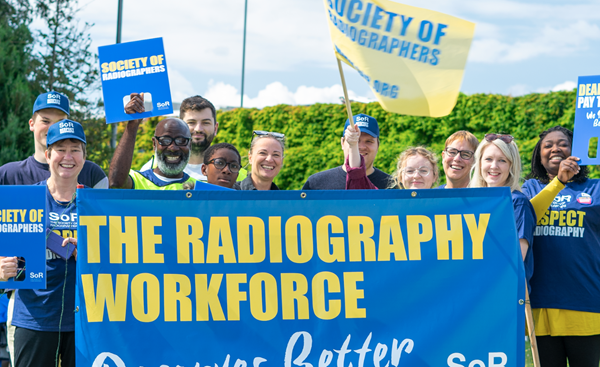Thousands of radiographers across England took 48 hours of strike action this week, beginning at 8am on Tuesday 25 July and finishing at 8am today, Thursday 27 July.
Members in Trusts including the Royal Marsden, University College London Hospitals, Liverpool University Hospitals and Sheffield Teaching Hospitals took to the picket lines to demand urgentimprovements to pay and conditions for the radiography workforce.
As the strike ends Dean Rogers, executive director of industrial strategy and member relations, has sent a letter to the health secretary, Steve Barclay, inviting him to meet to discuss ways of tackling the recruitment and retention problems besetting the profession – which have left one million patients on NHS waiting lists.
The full text of the letter follows below
Dear Secretary of State,
Re: Avoiding further industrial action
During our brief discussions with the Minister and your officials, following our members’ vote to support strike action, we were informed that your government would not be prepared to talk to us while dates of industrial action were in place. We have made it clear that our door is always open for meaningful engagement and constructive dialogue.
Now we have completed our first 48 hours of action, we hope that you will be prepared to meet us and seriously discuss ways to mitigate the current radiography workforce crisis.
During our action, both NHS Providers and NHS Employers have called on you to talk, and we hope that you will do so now, rather than promote the risk of an escalation in industrial action.
Our action highlighted the central importance of radiographers to NHS treatment pathways. Nine out of 10 patients are supported by radiographers, and doctors can’t diagnose confidently or safely without our members’ scans. Our members are also at the core of cancer treatment and prevention strategies.
Waiting lists have risen and continue to rise, because of the failure over almost two decades to invest enough in staff and equipment to meet known and forecast demand. The Richards Report identified how we have half the number of CT and MRI machines as France because of the political and investment choices made, especially since 2008.
We note that you have published your Workforce Strategy, which includes positive aspirations to recruit more allied health professionals in the long term. However, we feel an urgent need to meet to discuss how we can address the recruitment and retention crisis that is undermining these aspirations now.
Pay and reward is part of this. No business reliant on recruiting and retaining a skilled workforce could seriously hope to meet its aspirations by repeatedly making its employees relatively poorer and having senior leaders tell them to stop moaning. Our members’ frustration at the half-inflation pay increase has been amplified by seeing others in the public sector now offered more, while NHS staff bank colleagues have been denied part of the award. This needs to be revisited.
We believe that pay restoration must be addressed, too. Starting to do so now would be a signal of hope that can turn the tide of radiographers leaving the NHS. We understand that this cannot happen overnight. A new, longer-term approach is overdue, which is why we want to take the politics out of NHS pay. The solution rests in all stakeholders working together and committing to a new consensus around sustained investment to grow the radiography workforce to meet known demand.
We hope you will share this desire and agree to join us in serious, meaningful talks that map out a pathway to addressing the radiography workforce crisis.
We look forward to your response and hope that further industrial action will not be necessary.
Yours sincerely,
Dean Rogers
Executive Director of Industrial Strategy and Member Relations
Society of Radiographers

